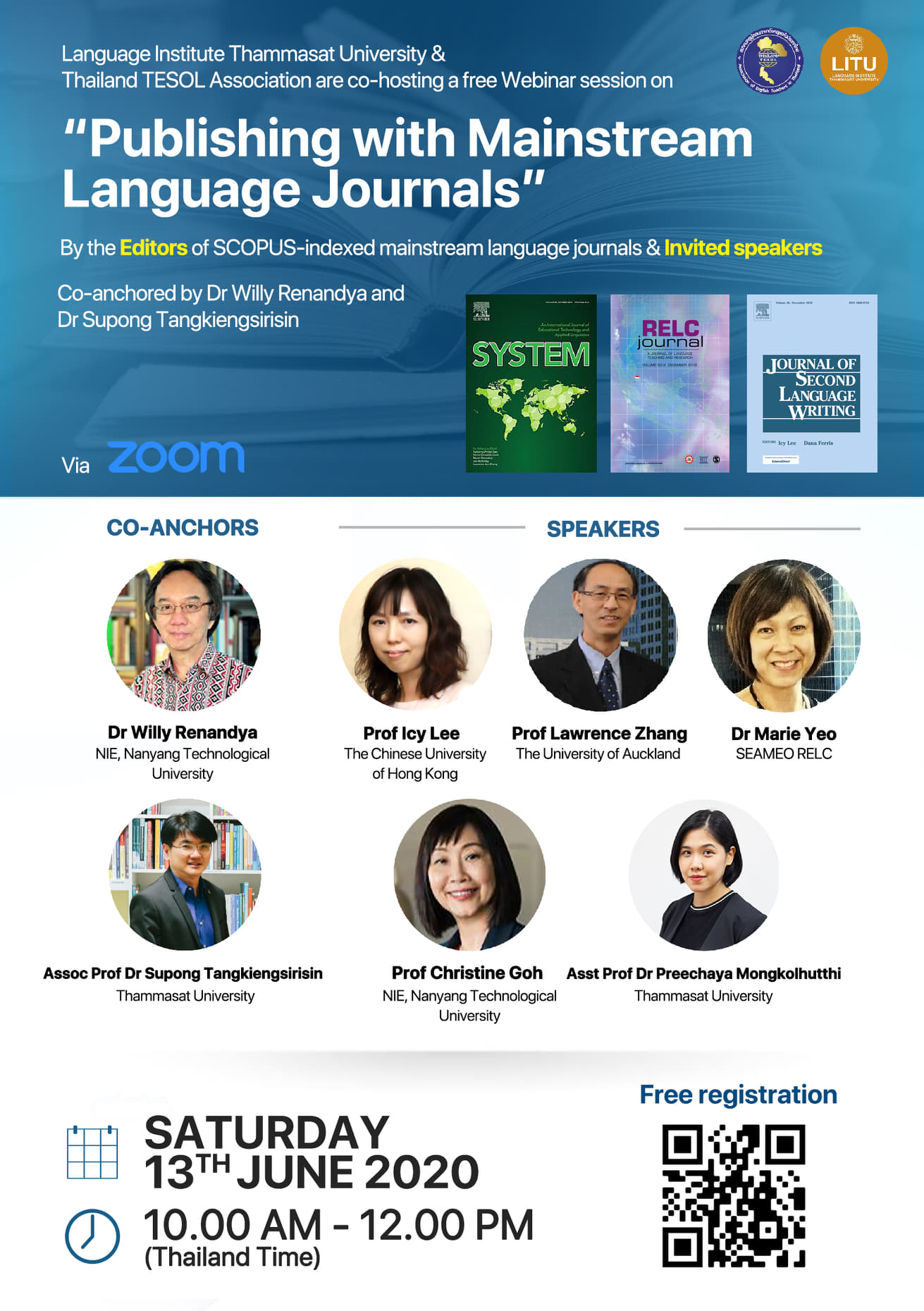In a webinar “Publishing with Mainstream Journals” hosted by ThaiTESOL and the Language Institute of Thammasat University (LITU) on 13 June 2020, five prominent TESOL/ELT scholars shared useful information and practical tips on journal publication.
They addressed a number of key questions that people in the TESOL/ELT community have about publishing in high profile journals, also known as Q1 journals. These are journals that are highly valued because of the wide recognition and impact these journals have on one’s academic career (e.g., job applications, contract renewal, promotion and tenure).
Here are some of the key questions that the three editors (Prof Icy Lee, Dr Marie Yeo and Prof Lawrence Zhang) addressed during the two-hour webinar session:
- Why is it so difficult to publish in Q1 journals?
- What are editors and reviewers looking for when assessing/evaluating a manuscript?
- What is your review process like? Why does the review process take so long?
- What happens if your reviewers disagree with each other (e.g., one accept; one reject)?
- Do Q1 journals accept only manuscripts submitted by experienced/renowned scholars?
- How do Q1 journals address the needs of early career researchers?
- What is a desk rejection? Does it often happen? What are some of the most common reasons for rejection?
- Does your journal publish long empirical papers only?
- Research papers in other fields (non-humanities) tend to be shorter, and they tend to attract more citations too. Is this something that your journals are considering in the near future?
- Can you increase the number of papers per issue? Also the number of issues per year? Why and why not?
The two ELT scholars (Prof Christine Goh and Prof Preechaya Mongkolhutti) shared their publishing experiences in response to the following questions
- What has been your experience publishing high impact journals?
- What do you do when your papers are rejected?
- What strategies do you use to increase your chance of acceptance?
- How long does it usually take you to write a journal article?
- What do you do to publish regularly (e.g., 2 or 3 papers per year)?
- How do you deal with/respond to reviewers’ comments?
- What advice would you offer to early career researchers?
- Which one is more important for early career researchers: quantity or quality of publications?
I co-chaired the session with Prof Supong Tangkiensirisin and found the session extremely useful. The speakers were excellent and generous in sharing their professional knowledge and experience about journal publications. Although journal publication is tough, they shared their thoughts in a very balanced and also positive manner.
The key message they tried to get across is this: Publishing in good journals is TOUGH, but DOABLE.
In fact the process of writing a paper, submitting it to a journal, receiving and reading comments and feedback from reviewers (which can sometimes be quite heart-breaking when the comments are harsh) can be a humbling and professionally enriching experience.
Here are some takeaways from the webinar:
Rejection is painful, but there is always a silver lining hidden in the long and detailed feedback given by reviewers. Our job is to make good use of their feedback (i.e., areas of weaknesses and suggestions for improvement) and use this as a basis for revising and rewriting our manuscript.
Rejection is an important part of the publication game. Treat it as your friend, not your enemy. If you have not been rejected before, you have not really learned much from the publication game.
Writing takes time. Like any other skills, practice is of critical importance. Regular (or daily) writing practice can develop, extend and refile our academic writing skills.
Never give up!. If your paper has been rejected, it is not the end of the world. There are hundred other journals awaiting your submission. They may not be your most preferred journals, but publishing with them enriches your publication experience.
Since writing takes time and getting it published can take up to one year, you will need to have a publication plan so that you can have one or two papers (or three) published every year. One strategy would be to not wait for your paper to be published before you start writing a new one. Ideally, you should have one paper accepted, one paper under review and one paper under revisions. This way, you will be able to get at least one paper published every year.
If you missed the webinar, you can watch the youtube video here.



Hi, I have tried to register but unsuccessfully. Email sudipchatterji@yahoo.com. One question that I find missing and is relevant is on rising costs of publications. Some journals are going up to 3000k Euro also. what’s the justification for such exorbitant cost since we know that the prices are not under scrutiny by governments presently?